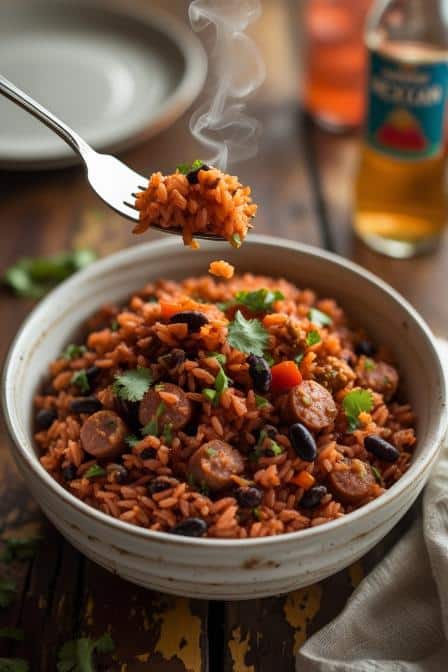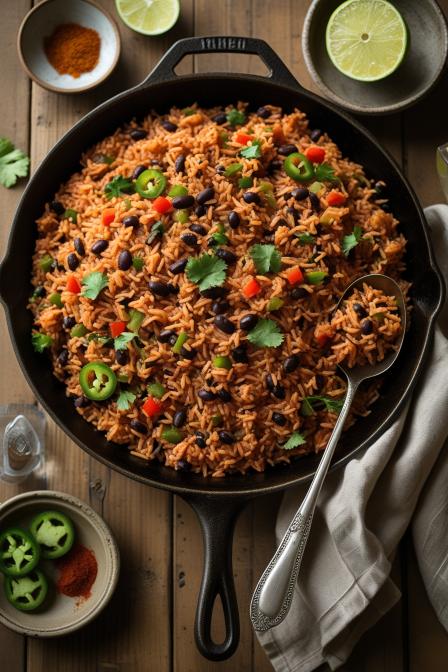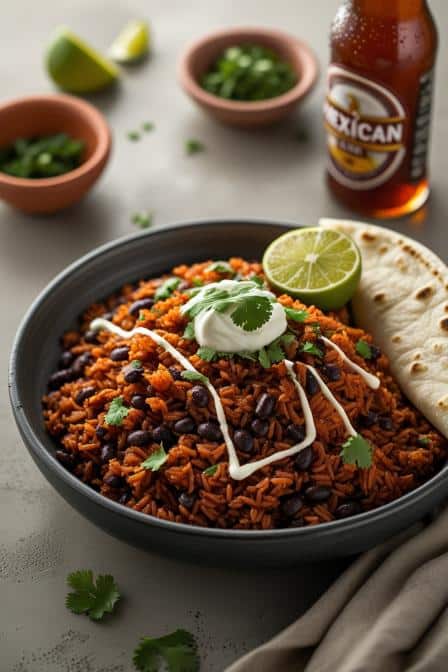The first time I tasted something like this, I was barefoot in a too-warm kitchen in Bangkok, hunched over a plastic bowl of rice that’d been spooned over with glistening, golden chicken. It was hot, sticky, and a little too sweet—but god, it sang. That bite taught me more than culinary school ever did about balance. Heat, acid, sweetness. And texture—never forget texture. These Sweet and Sticky Chicken Rice Bowls might look humble, but what they lack in glam, they make up for in punch-you-in-the-face flavor.
This dish isn’t just some random stir fry dumped over rice. It’s a story in a bowl. It’s weeknight relief and street-food fantasy all in one. Think tender chunks of chicken glazed in a glossy, syrupy sauce that clings to every grain of rice. The sauce? Deep with soy, kissed with ginger, garlic, and a sly lick of chili. Simple ingredients, complex soul. You’d never guess how stupidly easy it is to make.
What Are Sweet and Sticky Chicken Rice Bowls, Really?
Call it Asian-inspired comfort food or just an excuse to eat more rice—either way, this dish earns a spot on your repeat list. Boneless chicken (thighs preferred, but we’ll get to that) is seared until just golden, then simmered in a sauce that thickens into a sticky, rich coating. Poured hot over steamed rice and topped with crunchy bits—scallions, sesame seeds, maybe some quick-pickled veg—it becomes this chaotic, beautiful harmony.
What’s magic here isn’t just the flavor. It’s how it lets you riff. You can make it bold, tame, spicy, sweet, gluten-free, vegan, or loaded with add-ins. It’s a method as much as a recipe. And if you’re in a restaurant kitchen? This bowl flies off menus.
Ingredients & Substitutions
Picking the right ingredients ain’t about being fancy—it’s about flavor. If your garlic’s gone soft or your soy sauce tastes like salt water, your whole bowl’s doomed from the jump.
Here’s your roadmap:
| Ingredient | Purpose | Substitution Ideas |
|---|---|---|
| Boneless chicken thighs | Juicy, flavorful protein | Chicken breast (less moist), tofu (vegan), tempeh |
| Soy sauce | Salty umami base for sauce | Tamari (gluten-free), coconut aminos (soy-free) |
| Dark soy sauce (optional) | Adds color + depth | More regular soy + molasses drop |
| Brown sugar or honey | Sweetness + helps caramelize | Maple syrup, coconut sugar |
| Rice vinegar | Adds acidity to balance sweetness | Apple cider vinegar, lemon juice |
| Garlic (fresh) | Aromatic backbone | Garlic paste, roasted garlic (sweeter) |
| Ginger (fresh) | Warmth + depth | Ground ginger (half the amount), galangal (bolder) |
| Cornstarch | Thickens sauce | Arrowroot, tapioca starch |
| Sesame oil | Nutty finish | Skip or sub with a neutral oil if allergic |
| Cooked rice (jasmine/short) | Base of the bowl | Brown rice, quinoa, cauliflower rice |
| Scallions, sesame seeds | Garnish, crunch + visual appeal | Chives, crispy onions, crushed peanuts |
Ingredient Notes

Chicken thighs are forgiving. They don’t dry out like breasts. Thighs also soak up flavor like mad. Use skinless, boneless ones for quick cooking.
Soy sauce matters. Cheap soy sauce tastes flat—almost tinny. Go for naturally brewed varieties like Kikkoman or Yamasa. And brown sugar? Use dark brown for a deeper molasses kick. Trust me on this one.
Fresh garlic and ginger will always outshine the jarred stuff. The jar’s easy, yeah, but it lacks bite and aroma. You want that nose-tingling zing.
Step-by-Step Instructions
This is not the time to rush. Good things get sticky slow. Here’s how to nail it:
1. Prep your mise en place
Chop your chicken into bite-sized bits—about 1-inch chunks. Mince garlic and ginger fine. This ain’t a “slice and dump” dish. Tiny pieces mean quick cooking and even flavoring.
Mix your sauce: in a bowl, stir together soy sauce, dark soy if using, brown sugar, vinegar, sesame oil, garlic, ginger, and cornstarch. Whisk it until smooth, lump-free.
💡 Tip: Let the sauce sit for 5-10 minutes before using. The garlic and ginger mellow a touch, and the cornstarch hydrates better.
2. Sear the chicken
Heat a large non-stick or carbon steel skillet over medium-high. Add a little neutral oil (not olive oil—it burns too fast). Toss in the chicken in a single layer. Don’t move it for the first 1-2 minutes. Let it sear.
❌ Common Mistake: Overcrowding the pan. That steams the chicken instead of browning it. Do it in batches if you have to.
Flip once golden. Cook until just done (internal temp: 165°F/74°C). Remove and set aside. Keep warm.
3. Make it sticky
Lower the heat to medium. Pour in the sauce. Stir constantly. It’ll bubble, foam a bit, and then… thicken like magic. Once glossy and syrupy (about 2-3 minutes), return the chicken to the pan.
Toss to coat. Cook 1-2 more minutes so the sauce clings like lacquer.
🔥 Want it spicy? Add chili flakes or a squeeze of sriracha to the sauce.
4. Assemble your bowl
Spoon hot rice into bowls. Top with saucy chicken. Scatter scallions, sesame seeds, and whatever else makes you happy. I love a few thin cucumber slices or some pickled red onion for contrast.
🍋 Acid pop: Add a quick squeeze of lime on top. Cuts the richness beautifully.
Cooking Techniques & Science
Let’s nerd out for a sec.
Searing the chicken creates Maillard reaction—a cascade of tiny chemical reactions that build flavor. Browned meat = depth. Skipping this? You lose complexity.
Cornstarch thickens the sauce by forming a network of gelatinized starch. It also gives that glossy sheen. But it can clump if added hot. Always dissolve it in liquid first.
Sugar doesn’t just sweeten—it helps caramelize. That’s what gives the “sticky” part its edge. Sugar + heat + time = syrupy glaze. And that vinegar? Balances the whole thing so it doesn’t taste like candy.
Tools That Matter
- Wok or heavy-bottom skillet: Even heat is crucial. Don’t use flimsy pans.
- Microplane: Makes grating garlic and ginger faster and finer.
- Rice cooker: If you’re still boiling rice in pots, friend, it’s time.
Storage & Reheating
Let leftovers cool fully before storing. Keep in an airtight container for up to 4 days. Reheat gently over low heat with a splash of water to loosen the sauce. Microwave works in a pinch, but stovetop keeps textures better.
Don’t freeze it. The sauce texture gets weird.
Variations & Substitutions
Vegan Version
Swap chicken for crispy tofu or seared tempeh. Use agave instead of honey, and tamari for soy.
Gluten-Free
Make sure your soy sauce or tamari is labeled gluten-free. Avoid dark soy unless you verify the brand.
Sweet & Spicy
Add gochujang or Thai chili paste. Try a bit of pineapple juice in place of some vinegar for a tropical twist.
Serving & Pairing Suggestions

Presentation’s half the experience. Serve in shallow bowls. Let the chicken shine against the rice—don’t bury it.
Garnish with:
- Chopped scallions
- Toasted sesame seeds
- Thinly sliced chili
- Crispy shallots
- Quick cucumber salad
Drink Pairings
- Thai iced tea (sweet-on-sweet works here)
- Dry Riesling or chilled sake
- Jasmine tea or cold brew oolong
Side Pairings
- Steamed edamame
- Garlic Chinese broccoli
- Kimchi or pickled daikon
- A soft-boiled egg with soy drizzle? Always yes.
Best Time to Serve or Eat This Dish
Honestly? Any night you need a hug in a bowl. It’s perfect for weeknights, fast enough for meal prep, and fancy enough to serve to guests with just a sprinkle of toasted sesame flair.
Rainy day? Perfect. Hungover? Oh, hell yes. Even cold, it still slaps.
Conclusion
Sweet and Sticky Chicken Rice Bowls might sound simple—but they’re kind of a chef’s secret weapon. Fast, flexible, and packed with addictive flavor. Every component has a reason, every step a purpose.
Balance is everything: sweet vs salty, soft vs crunchy, warm rice vs cool toppings. Master this once and you’ll have a blueprint for infinite spins—spicy, vegan, fusion, whatever. That’s the beauty of it.
Want a final tip? Always double the sauce. You’ll thank me when you’re licking your plate.
FAQs
1. Can I use frozen chicken?
Yes, just thaw completely and pat dry before cooking. Moisture = soggy mess.
2. What rice works best?
Jasmine or short-grain is ideal. They’re sticky enough to carry sauce without getting mushy.
3. Can I make it ahead?
Totally. Just store rice and chicken separately. Assemble when reheating for best texture.
4. Why did my sauce turn gloopy?
You probably overheated it after adding cornstarch. Stir constantly and stop cooking once thick.
5. Is this dish spicy?
Not inherently. The base is sweet-savory. Add heat if you want it.
Let your bowl be messy, the chicken be glossy, and your bite be unforgettable. That’s how you know you did it right.

